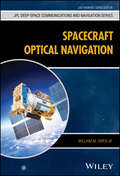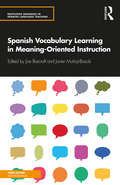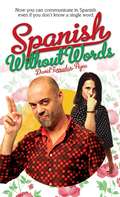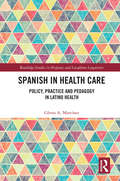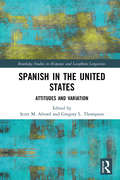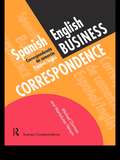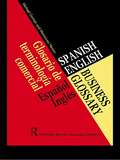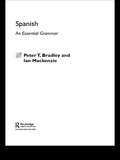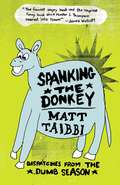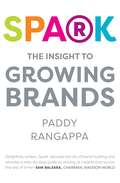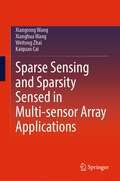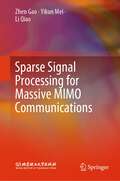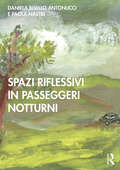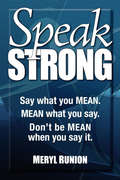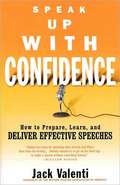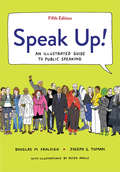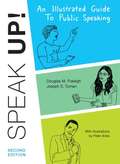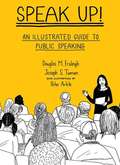- Table View
- List View
Spacecraft Optical Navigation (JPL Deep-Space Communications and Navigation Series)
by William M. Owen Jr.UNIQUE RESOURCE EXPLORING HOW SPACECRAFT IMAGERY PROVIDES PROFESSIONALS WITH ACCURATE ESTIMATES OF SPACECRAFT TRAJECTORY, WITH REAL-WORLD EXAMPLES AND DETAILED ILLUSTRATIONS Spacecraft Optical Navigation provides detailed information on the planning and analysis of spacecraft imagery to help determine the trajectory of a spacecraft. The author, an experienced engineer within the field, addresses the entirety of celestial targets and explains how a spacecraft captures their imagery. Aimed at professionals within spacecraft navigation, this book provides an extensive introduction and explains the history of optical navigation, reviewing a range of optical methods and presents real world examples throughout. With the use of mathematics, this book discusses everything from the orbits, sizes, and shapes of the bodies being imaged, to the location and properties of salient features on their surfaces. Specific sample topics covered in Spacecraft Optical Navigation include: History of various past spacecraft, including Mariner and Viking, Voyager, Galileo, NEAR Shoemaker, and Cassini, and flight hardware, star catalogs, and stereophotoclinometryCameras, covering the gnomonic projection (and deviations from it), creation of a digital picture, picture flattening, and readout smearsModeling optical navigation observables, covering apparent directions to an object, star, and limbs or terminators, and orientation of camerasObtaining optical navigation observables, covering centerfinding for stars and resolved and unresolved bodies, and using opnav data in orbit determination Spacecraft Optical Navigation is an ideal resource for engineers working in spacecraft navigation and optical navigation, to update their knowledge of the technology and use it in their day-to-day. The text will also benefit researchers working with spacecraft, particularly in navigation, and professors and lecturers teaching graduate aerospace courses.
Spanish Business Situations: A Spoken Language Guide (Business Situations Ser.)
by Michael Gorman Maria-Luisa HensonSpanish Business Situations is a handy reference and learning text for all who use or need spoken Spanish for business. Over 40 situations are simply presented, including * basic phone calls * leaving messages * making presentations * comparing, enquiring, booking * selling techniques With full English translations and usage note, Spanish Business Situations will help you to communicate confidently and effectively in a broad range of everyday business situations.
Spanish Heritage Learners' Emerging Literacy: Empirical Research and Classroom Practice (Routledge Advances in Spanish Language Teaching)
by Flavia Belpoliti Encarna BermejoSpanish Heritage Learners' Emerging Literacy: Empirical Research and Classroom Practice introduces a comprehensive, multi-level empirical study on the writing abilities of Spanish Heritage Learners at the beginner level; the findings guide a broad selection of instructional activities and pedagogical resources to support writing development in the heritage language classroom. This is the first book dealing exclusively with writing competence among Spanish Heritage Language Learners through the integration of empirical evidence and instructional perspectives to address core questions on heritage language literacy. In addition to the in-depth analysis of Spanish production—spelling, verb usage, grammatical features, vocabulary, and discourse organization—the volume revises the latest perspectives within the Heritage Language Education field, and provides effective teaching approaches, innovative classroom implementations, and up-to-date resources. This versatile volume, designed for researchers and practitioners in the fields of Bilingual Education, Language Teaching Methods, and Heritage Language Pedagogy, integrates empirical evidence, global perspectives on heritage language teaching, and suggestions for further research.
Spanish Vocabulary Learning in Meaning-Oriented Instruction (Routledge Advances in Spanish Language Teaching)
by Javier Muñoz-Basols Joe BarcroftSpanish Vocabulary Learning in Meaning-Oriented Instruction is the first comprehensive overview of current research and instructional practices into Spanish vocabulary acquisition through the lens of Meaning-Oriented Instruction (MOI). Key features: • a breadth of topics including language variation, input, tasks and processing specificity, incidental learning, idiomatic language, lexicographic perspectives, lexicosemantic representation, vocabulary testing, and receptive and productive vocabulary; • a combination of theory and practical guidance highlighting pedagogical best practices in the teaching of vocabulary; • guidance on the difficulties teachers face when teaching vocabulary in the classroom; • clear explanations with plenty of examples and useful references; • tasks and activities that help teachers move from a traditional curricular approach to a more innovative and engaging one focused on communicating, completing tasks, and learning content. Written by an international cohort of scholars in a succinct and accessible manner, Spanish Vocabulary Learning in Meaning-Oriented Instruction is an essential resource for teachers of Spanish at all levels. It is also an excellent reference book for researchers and both undergraduate and graduate students interested in Spanish vocabulary acquisition.
Spanish Without Words
by David Tarrada AgeaYou don't need words to speak Spanish. All you really need is this unique "phrase book" of the most common Spanish expressions, complete with authentic Spanish gestures and body language. It's the fastest and funniest way to learn Spanish ever published.You don't need words to speak Spanish. You don't have to study Spanish, or travel to Spain or Latin America to communicate in Spanish, either. All you really need is this unique "phrase book" of the most common Spanish expressions, complete with authentic Spanish gestures and body language. It's the fastest and funniest way to learn Spanish ever published. Now, even if you don't know a single word of Spanish, you can learn the most common greetings and expressions, dinner-table comments, hot vows of love, bargaining tricks, insults, threats and curses. This book shows you how. There's no faster or funnier way to learn how to communicate in Spain or Latin America, in Spanish, Mexican, Puerto Rican or Argentinian restaurants, with your grandparents or your friends.
Spanish at Work
by Nuria Lorenzo-DusSpanish at Work is the first book examining the discourse practices of institutions in the Spanish-speaking world. It focuses on three 'umbrella' institutions (the mass-media, politics and the workplace), each of which are explored through a discrete theme. Within the mass media, chapters focus on the relationship between language and identity; within the political domain, persuasion and performance are investigated; and within the workplace, chapters explore the negotiation of interpersonal relations in work-related activity types. Spanish at Work delves into a varied selection of countries and settings in which Spanish is spoken variously as one of several official languages, as the official language, as a 'minority' language, and even as a second language or one of a number of other languages. Spanish at Work will be essential reading for upper-level undergraduates and graduates in Spanish linguistics and discourse analysis, as well as for practitioners in these fields.
Spanish in Health Care: Policy, Practice and Pedagogy in Latino Health (Routledge Studies in Hispanic and Lusophone Linguistics)
by Glenn A. MartínezSpanish in Health Care fills an important gap by offering a panoramic overview of the research on Spanish in health settings that is emerging from a variety of disciplines. Synthesizing research from diverse disciplines such as sociolinguistics, discourse analysis, health services research, behavioral health research, health policy and administration, and social epidemiology, the volume offers a uniquely unified approach to the subject of Spanish in healthcare. This volume will be of interest to researchers in Spanish linguistics, sociolinguistics, health communication, and languages for specific purposes.
Spanish in the United States: Attitudes and Variation (Routledge Studies in Hispanic and Lusophone Linguistics)
by Scott M. Alvord Gregory L. ThompsonSpanish in the United States: Attitudes and Variation is a collection of new, cutting-edge research with the purpose of providing scholars interested in Spanish as it is spoken by bilinguals living in the United States a current view of the state of the discipline. This volume is broad and inclusive of the populations studied, methodologies used, and approaches to the linguistic study of Spanish in order to provide scholars with an up-to-date understanding of the complexities of the Spanish(es) spoken in the United States. In addition to this snapshot, this volume stimulates new areas of inquiry and motivates new ways of analyzing the social, linguistic, and educational aspects of what it means to speak Spanish in the United States.
Spanish/English Business Correspondence: Correspondecia de comercio Espanol/Ingles
by Michael Gorman Maria-Luisa HensonFirst published in 1997. Routledge is an imprint of Taylor & Francis, an informa company.
Spanish/English Business Glossary
by Michael Gorman Maria-Luisa HensonThis is the essential reference companion for all who use Spanish for business communication.Containing over 5000 words, this handy two-way A-Z glossary covers the most commonly used terms in business. It will help you to communicate with confidence in a wide variety of business situations, and is of equal value to the relative beginner or the fluent speaker.Written by an experienced native and non-speaker team working in business language education, this unique glossary is an indispensable reference guide for all students and professionals studying or working in business where Spanish is used.
Spanish: An Essential Grammar (Routledge Essential Grammars)
by Ian Mackenzie Peter T BradleySpanish: An Essential Grammar is a concise and user-friendly reference guide to the most important aspects of Spanish.It presents a fresh and accessible description of the language that combines traditional and function-based grammar. The book sets out the complexities of Spanish in short, readable sections, and explanations are clear and free from jargon.The Grammar is the ideal reference source for the learner and user of Spanish. It is suitable for either independent study or for students in schools, colleges, universities and adult classes of all types. Features include:* clear distinctions between the essential and basic aspects of Spanish grammar and those that are more complex* full use of authentic examples* easy to understand explanations of areas that customarily pose problems for English speakers* detailed contents list and index for easy access to information.
Spanking the Donkey: Dispatches from the Dumb Season
by Matt Taibbi"Spanking the Donkey" indicts the surreal irrelevance of today's mainstream politics with barbed wit and caustic intelligence. Follow Taibbi as he covers the primary for the 2004 presidential election, joining him for a spot on John Kerry's campaign plane, face-to-face encounters with John Edwards's pancake makeup, and more.
Spark: The Insight to Growing Brands
by Paddy RangappaSpark addresses the important issue of growing bands in an increasingly competitive, crowded market place. Written by an expert in marketing, here is a book that demystifies the esoteric subject of brand-building. Spark achieves this by providing a practical framework. It handholds the reader through the various stages of brand-building—how to generate an insight to address a specific business challenge; how to construct a full business plan around it; and how to leverage such a plan for revenue growth. Rich in case-studies of successful global brands like Dove, McDonald’s and Vicks VapoRub, and replete with brainstorming tips and catchy acronyms for developing successful brand campaigns with ad agencies, Spark offers a lifeline to the professional committed to building and nurturing a powerful brand.
Sparse Sensing and Sparsity Sensed in Multi-sensor Array Applications
by Xiangrong Wang Xianghua Wang Weitong Zhai Kaiquan CaiThe book focuses on sparse multi-sensor array systems and design approaches. Both principles and engineering practice have been addressed, with more weight placed on algorithm development. This is achieved by providing an in-depth study on sparse sensing for several major multi-sensor array applications such as beam-pattern synthesis, adaptive beamforming, target detection, arrival angle estimation, and dual-functional radar communications. Sparsity sensed in multi-sensor arrays refers to the sparse property of the spatial spectrum sensed. The exploitation of the sparsity in the sensed can significantly enhance the performance of signal processing systems. The comprehensive and systematic treatment of theory and practice in different array applications is one of the major features of the book, which is particularly suited for readers who are interested to learn practical solutions in array signal processing. The book benefits researchers, engineers, and graduate students in the fields of signal processing, electrical engineering, telecommunications, etc.
Sparse Signal Processing for Massive MIMO Communications
by Li Qiao Zhen Gao Yikun MeiThe book focuses on utilizing sparse signal processing techniques in designing massive MIMO communication systems. As the number of antennas has been increasing rapidly for years, extremely high-dimensional channel matrix and massive user access urge for algorithms with much higher efficiency. This book provides in-depth discussions on compressive sensing techniques and simulates the performance on wireless systems. The easy-to-understand instructions with detailed simulations and open-sourced codes provide convenience for readers such as researchers, engineers, and graduate students in the fields of wireless communications.
Spatial Optical-Fiber Coupling Technology in Optical-Wireless Communication (Optical Wireless Communication Theory and Technology)
by Xizheng KeThis book analyzes the development of space light-fiber coupling research, highlights its importance, examines the underlying theory and key problems, and elaborates on methods to improve the space light-fiber coupling efficiency. Starting from the basic theory of electromagnetic field, the transmission characteristics of light in optical fibers are expounded, and the coupling characteristics of optical signals of different modes are investigated. The spatial light-fiber coupling techniques such as mode conversion method, lens coupling method, and wavefront distortion correction method are discussed in detail, and the key technologies involved are verified by experiments. This book is suitable for the vast majority of engineering and technical personnel and teachers in colleges and institutions who are engaged in wireless optical communication. It can also be used to train senior undergraduates and graduate students in relevant fields.
Spazi Riflessivi in Passeggeri Notturni
by Daniela Bisello Antonucci Paola NastriSpazi Riflessivi in Passeggeri Notturni è un testo innovativo e versatile per l’insegnamento dell’italiano tramite riflessioni ed elaborazioni su questioni sociali emerse dalla lettura di Passeggeri notturni, racconti brevi di Gianrico Carofiglio. Il testo, indicato per un livello intermedio-avanzato, propone una vasta gamma di esercizi grammaticali contestualizzati e attività interdisciplinari che confrontano letterature e arti diverse e affrontano discussioni socio-culturali.
Speak Like A Pro: 10 Commandments of Public Speaking
by Comfort Ocran Albert OcranLearn more about good habits of public speaking that will inspire, entertain and educate your listeners
Speak Strong: Say What You Mean! Mean What You Say. Don't Be Mean When You Say It
by Meryl Runion“Speak Strong!” It’s a leadership skill, a success strategy and a moral imperative. Research shows 90% of us stay silent in situations that call for strong words. Don’t want to rock the boat? Author Meryl Runion, CSP, explains why some boats NEED to be rocked…for the right reasons…at the right time…in the right way. Know when it’s time to speak up, overcome resistance to unwelcome truths, establish and implement boundaries, create new communication standards, supercharge your message, elevate the quality of your conversations, overcome destructive communication habits, put your best foot forward sincerely. One hour audio CD included containing the entire searchable PDF of the bestselling PowerPhrases! book so you can immediately get the words to apply your SpeakStrong skills. The CD also includes a communication style inventory, the flash presentation of "The Legend of Mighty Mouth and of A World of Truth" and more. Meryl Runion’s "PowerPhrases!" book Series has helped over a quarter million readers find the perfect phrases to communicate clearly. “Speak Strong” is the perfect “next step” for those who rely on communication skills to build successful careers and relationships.
Speak Up with Confidence: How to Prepare, Learn, and Deliver Effective Speeches
by Jack ValentiPublic speaking is one of the most intimidating and important aspects of many jobs. As a one-time speechwriter for President Johnson, and in his current position as president of the Motion Picture Association of America, Jack Valenti has written and delivered speeches in all kinds of settings. Originally published in 1982, Speak Up with Confidence is an indispensable resource for anyone who wants to write and deliver a speech that people will listen to and remember.
Speak Up!: A Woman's Guide to Presenting Like a Pro
by Cyndi Maxey Kevin E. O'ConnorThe insider's guide for women who want to master the art of business, professional, and public speakingWhether speaking one-on-one or one to one thousand, women have specific challenges that can get in the way of their ability to convey ideas and engage an audience. Public speaking professionals Cyndi Maxey and Kevin O'Connor give women the tips and tools they need to be able to speak clearly, with confidence and conviction, and present information effectively.In SPEAK UP!, you'll learn how to:Deal with difficult colleaguesSpeak on the spotUse technology in support of your messageSell your ideas with passion and power Connect confidently with your superiorsFor any woman who wants to get her point across, from the boss' office, to the conference room, to a convention center, SPEAK UP! will help you polish your presentation skills, get heard, and get what you want.
Speak Up!: An Illustrated Guide To Public Speaking
by Douglas Fraleigh Joseph TumanWritten by professors with 40+ combined years’ experience teaching the course and a competitive background in debate, Speak Up! connects with students through lively writing, compelling real-life examples, practical guidance, and hundreds of custom-drawn illustrations that bring public speaking concepts to life. Instructors will appreciate the book’s serious coverage of concepts and theories, fascinating examples, and unique and often humorous illustrations that help students understand and retain concepts from the text. <p><p> This edition features new illustrations, in full color for the first time; an increased focus on civic engagement throughout; and an all-new version of our Speech Choices case study feature that leads students through all steps of the public speaking process. Video of that student’s final, full-length speech appears in LaunchPad, a comprehensive digital resource to accompany the book, alongside additional speech videos, a new video assessment program powered by GoReact, an adaptive quizzing program, and more.
Speak Up!: An Illustrated Guide to Public Speaking
by Douglas M. Fraleigh Joseph S. TumanSpeak Up! is a lively but thorough approach to public speaking aimed to support student confidence and successful speeches.
Speak Up: An Illustrated Guide To Public Speaking
by Douglas M. Fraleigh Joseph S. TumanSmart, compelling, fun, and affordable,Speak Up connects with students through great writing, useful guidance, and hundreds of custom-drawn illustrations that bring speech to life. Instructors appreciate the book's serious coverage of concepts and theories, fascinating real-life examples, and visual explanations that clarify complex ideas. And all this comes at less than half the price of competing texts.
Speak Up: An Illustrated Guide to Public Speaking
by Douglas M. Fraleigh Joseph S. Tuman Peter Arkle"Speak Up "is a new, brief, and fully illustrated public speaking text that is traditionally organized, affordable, and definitely fun. It combines thorough coverage of classical and contemporary communication theory, practical nuts-and-bolts guidance, and 600+ custom-drawn illustrations that bring speech basics "to life," And if that's not enough, "Speak Up "is priced at about 40% less than traditional introductory texts. Instructors and student reviewers have been raving about it, and your students will love it!
